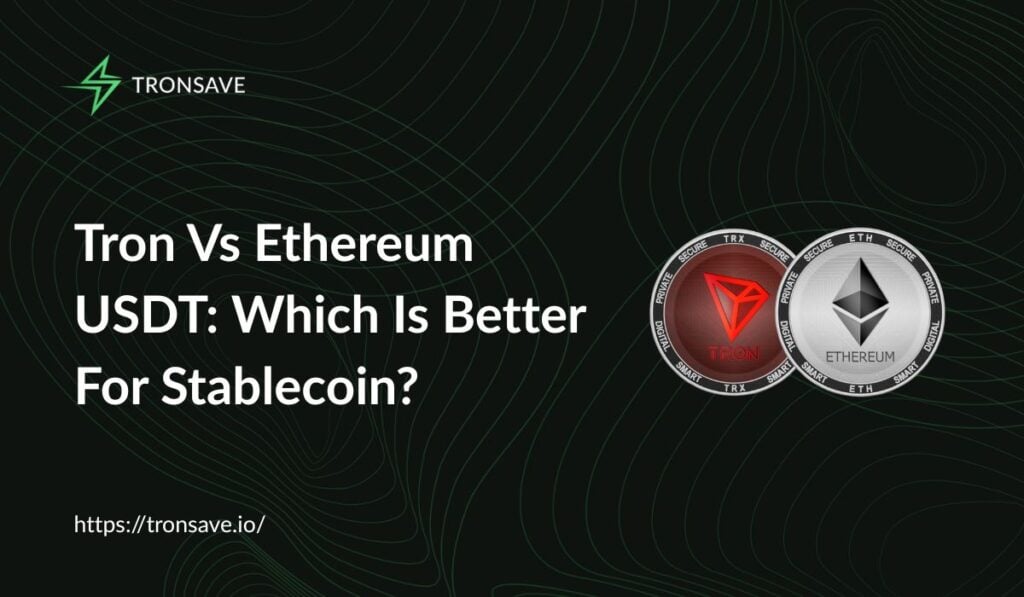
Understanding Tron and Ethereum for USDT transactions
Key Insight: TRC-20 and ERC-20 USDT are equal in value, but their blockchains differ in cost, speed, and ecosystem support.
Transaction fees: Ethereum’s edge in certain scenarios
- Ethereum: $1-$5 on Layer 2, $3-$20 on mainnet.
- Tron: 13.5 TRX ($3.38) to 27.3 TRX ($6.83).
For frequent small transfers, Ethereum’s Layer 2 solutions can undercut Tron’s fees. However, Tron’s fees are more predictable, and you can slash them by up to 84% with Tronsave, reducing costs to ~5.24 TRX ($1.31) per transfer. Wham!—a $6.83 fee on Tron feels like a brick, but Tronsave makes it a breeze.
Transaction speed and network performance
Why speed matters
Tron’s near-instant confirmations are perfect for merchants or DeFi users needing quick settlements. Ethereum’s Layer 2 solutions close the gap but may still lag during mainnet congestion.
Scalability considerations
Tron’s high TPS ensures consistent performance, even during peak usage. Ethereum’s scalability has improved with Layer 2, but mainnet bottlenecks can occur during DeFi surges.
Liquidity and ecosystem adoption
Ethereum’s ERC-20 USDT dominates liquidity, supported by nearly all major exchanges (e.g., Binance, Coinbase) and DeFi platforms like Uniswap and Aave. This makes it the top choice for traders and DeFi enthusiasts. Tron’s TRC-20 USDT, while growing, excels in Asian markets and OTC trading platforms like OKX and Bybit, handling $24.6 billion daily in USDT compared to Ethereum’s $10.5 billion.
- Ethereum: High liquidity, extensive DeFi integration.
- Tron: Strong in Asia, leads in USDT transaction volume.
For global trading or DeFi, Ethereum’s ecosystem is unmatched. For high-volume transfers in Asia, Tron’s TRC-20 is king.
Security and decentralization
Ethereum’s decentralized network, with thousands of nodes, makes ERC-20 USDT a safer choice for high-value transfers. Tron’s delegated proof-of-stake (DPoS) model, with 27 Super Representatives, is less decentralized, raising slight centralization concerns. Both blockchains are reliable for everyday USDT transfers, but Ethereum’s battle-tested security shines for large sums.
Ethereum’s robust security
Ethereum’s history of securing billions in USDT makes it a trusted pick for institutional users.
Tron’s practical reliability
Tron’s DPoS ensures fast, dependable transactions for retail users, though it sacrifices some decentralization.
Use cases: When to choose Tron or Ethereum for USDT
Your choice of Tron vs Ethereum USDT depends on your priorities. Here’s a comparison table:
| Feature | Tron (TRC-20) | Ethereum (ERC-20) |
| Transaction Fees | 13.5 TRX ($3.38) to 27.3 TRX ($6.83) | $1-$5 (Layer 2), $3-$20 (mainnet) |
| Transaction Speed | ~3 seconds | 5-20 seconds |
| Liquidity | Moderate, Asia-focused | High, global acceptance |
| DeFi Integration | Limited | Extensive (Uniswap, Aave, etc.) |
| Security | Reliable, less decentralized | High, battle-tested |
| Best For | Remittances, OTC, high-volume trades | DeFi, trading, high-value transfers |
Best for remittances and high-volume trades
Tron’s TRC-20 excels for frequent, high-volume USDT transfers, especially in Asia, with 283 million transactions processed in 2025. Save up to 84% on fees with Tronsave.
Best for DeFi and trading
Ethereum’s ERC-20 USDT is ideal for DeFi and trading, leveraging its liquidity and integration with platforms like Uniswap.
FAQ: Common questions about Tron vs Ethereum USDT
How do I know if my USDT is TRC-20 or ERC-20?
TRC-20 addresses start with “T” (e.g., TAbc123), while ERC-20 addresses begin with “0x” (e.g., 0xabc123). Always confirm with the recipient to avoid errors.
Can I send TRC-20 USDT to an ERC-20 address?
No, they’re on different blockchains. Sending to the wrong address risks losing funds. Double-check the network first.
How can I reduce TRC-20 USDT fees?
Stake ~60,000 TRX for ~10 daily transfers or rent energy via Tronsave for ~5.24 TRX ($1.31) per transfer, saving up to 84%.
Is Ethereum’s USDT safer than Tron’s?
Ethereum’s decentralization makes ERC-20 USDT safer for large transactions, but Tron’s TRC-20 is reliable for smaller, frequent transfers.
Conclusion



